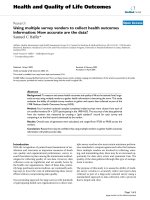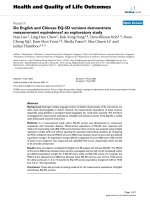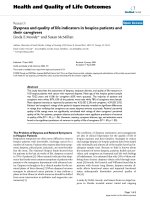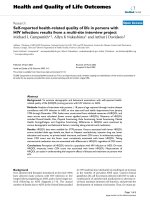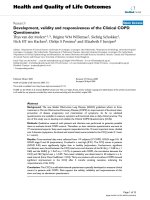Health and Quality of Life Outcomes BioMed Central Research Open Access Is quality of life pot
Bạn đang xem bản rút gọn của tài liệu. Xem và tải ngay bản đầy đủ của tài liệu tại đây (264.56 KB, 8 trang )
BioMed Central
Page 1 of 8
(page number not for citation purposes)
Health and Quality of Life Outcomes
Open Access
Research
Is quality of life measurement likely to be a proxy for health needs
assessment in patients with coronary artery disease?
Mohsen Asadi-Lari*
1
, Chris Packham
2
and David Gray
1
Address:
1
Division of Cardiovascular Medicine, University Hospital, Nottingham, NG7 2UH, UK and
2
Division of Epidemiology & Public Health,
University of Nottingham, UK
Email: Mohsen Asadi-Lari* - ; Chris Packham - ;
David Gray -
* Corresponding author
Healthcare needs assessmentCoronary artery diseaseHealth-related quality of life
Abstract
Background: The identification of patients' health needs is pivotal in optimising the quality of
health care, increasing patient satisfaction and directing resource allocation. Health needs are
complex and not so easily evaluated as health-related quality of life (HRQL), which is becoming
increasingly accepted as a means of providing a more global, patient-orientated assessment of the
outcome of health care interventions than the simple medical model. The potential of HRQL as a
surrogate measure of healthcare needs has not been evaluated.
Objectives and method: A generic (Short Form-12; SF-12) and a disease-specific questionnaire
(Seattle Angina Questionnaire; SAQ) were tested for their potential to predict health needs in
patients with acute coronary disease. A wide range of healthcare needs were determined using a
questionnaire specifically developed for this purpose.
Results: With the exception of information needs, healthcare needs were highly correlated with
health-related quality of life. Patients with limited enjoyment of personal interests, weak financial
situation, greater dependency on others to access health services, and dissatisfaction with
accommodation reported poorer HRQL (SF-12: p < 0.001; SAQ: p < 0.01). Difficulties with
mobility, aids to daily living and activities requiring assistance from someone else were strongly
associated with both generic and disease-specific questionnaires (SF-12: r = 0.46-0.55, p < 0.01;
SAQ: r = 0.53-0.65, p < 0.001). Variables relating to quality of care and health services were more
highly correlated with SAQ components (r = 0.33-0.59) than with SF-12 (r = 0.07-0.33). Overall,
the disease-specific Seattle Angina Questionnaire was superior to the generic Short Form-12 in
detecting healthcare needs in patients with coronary disease. Receiver-operator curves supported
the sensitivity of HRQL tools in detecting health needs.
Conclusion: Healthcare needs are complex and developing suitable questionnaires to measure
these is difficult and time-consuming. Without a satisfactory means of measuring these needs, the
extent to which disease impacts on health will continue to be underestimated. Further investigation
on larger populations is warranted but HRQL tools appear to be a reasonable proxy for healthcare
Published: 04 October 2003
Health and Quality of Life Outcomes 2003, 1:50
Received: 19 June 2003
Accepted: 04 October 2003
This article is available from: />© 2003 Asadi-Lari et al; licensee BioMed Central Ltd. This is an Open Access article: verbatim copying and redistribution of this article are permitted in all
media for any purpose, provided this notice is preserved along with the article's original URL.
Health and Quality of Life Outcomes 2003, 1 />Page 2 of 8
(page number not for citation purposes)
needs, as they identify the majority of needs in patients with coronary disease, an observation not
previously reported in this patient group.
Introduction
Clinical triallists assess a treatment under evaluation
according to specific clinical 'endpoints', typically mortal-
ity or morbidity, or some measure of health service utili-
sation, such as length of hospital stay; similar endpoints
have become the standard set in national frameworks [1]
and college guidelines [2]. Doctors generally record how
successful a medical intervention has been in terms of the
extent of symptom relief or the technical success of a pro-
cedure. Patients, however, measure the impact of disease
in terms of general health status and of quality of life and
describe the effectiveness of treatment as the extent to
which their health care needs have been met.
Managing population health needs is central to modern
healthcare systems [3], regardless of the sophisticated con-
cept and inherent complexity of 'needs'. A well-known
definition of needs, which is not without criticism [4], is
'what people could benefit from health services' [5]; this draws
attention to the importance of measuring the outcome of
a health intervention. Considering a medical intervention
as successful if it has a measurable favourable outcome
may satisfy a target in one national service framework or
another but is of limited importance to an individual
since it completely ignores the patient's perspective of his
or her needs.
Target-driven standards in areas of health care with a high
political profile appear to be replacing the concept of uni-
versal provision, which warrants quantifying outcomes of
health care. Identifying who might benefit from these
health services is equally important if scarce resources are
to be fully and appropriately utilised. If the goal of care is
optimal health, the key marker of success ought to be to
ascertain individual patients' health care needs (HCN)
and tailor services accordingly.
Developing a comprehensive, valid and reliable HCN
assessment tool is not straightforward, requiring the
aggregation of information from a wide variety of sources
[6]; this perhaps explains the lack of such tools compared
with the more widely accepted quality of life tools such as
the Nottingham Health Profile [7] and the Short-Form 36
[8]. Producing a health needs assessment tool involves a
qualitative review of professional and patient opinion and
all available health service information and a variety of
internal checks to achieve validity and reliability.
We hypothesised that there was a direct relationship
between health-related quality of life and health needs. If
such a relationship were proven, health related quality of
life, which is more simply measured, could be assessed in
every patient and a more lengthy and detailed analysis of
HCN reserved for those with impaired quality of life.
Method
In the absence of an available tool for healthcare needs
assessment of patients with coronary heart disease
(CHD), we developed our own questionnaire (Notting-
ham Health Needs Assessment: NHNA), derived from the
literature, expert views and information compiled at inter-
view. Following in-hospital testing and amendments, a
satisfactory format for the questionnaire was established.
The NHNA comprised a wide range of parameters includ-
ing demographic data, employment, mobility and trans-
port, access to local heath care facilities, information
needs and concerns, availability of carers, current health
care, accommodation, education, leisure, and social
facilities.
Patients admitted to the acute cardiac unit of Queen's
Medical Centre, Nottingham with cardiac-sounding chest
pain were invited to take part in the study, which had local
Ethical Committee approval. All patients participated in a
semi-structured interview during the hospital stay.
One month after discharge, patients were sent NHNA and
two health-related quality of life (HRQOL) question-
naires (described below) to be completed at home and
returned by post. Data from the second test were analysed
to compare the needs assessment tool with quality of life
questionnaires.
Seattle Angina Questionnaire (SAQ)
This consists of 19 items grouped in five components:
physical functioning (SAQ Phys), angina stability (AS),
angina frequency (AF), treatment satisfaction (TS), and qual-
ity of life perception (SAQ QOL). The SAQ measures
broader aspects of CHD effects than other disease-specific
tools. SAQ has well-established psychometric properties
and can detect physical limitations due to coronary dis-
ease, in particular in the presence of when there is co-mor-
bidity [9]. Corresponding well with the Canadian
Cardiovascular Society Classification [10].
Short Form 12 (SF-12)
The Short Form 36 (SF-36) [8] has produced consistent
results in several European countries and in a diverse
range of conditions; the SF-12 is an abridged form of this.
It contains 12 questions from which are derived physical
Health and Quality of Life Outcomes 2003, 1 />Page 3 of 8
(page number not for citation purposes)
and mental component scores (PCS & MCS) which are as
precise as the SF-36 [11,12].
Statistical analysis
Data were analysed using SPSS v11. Frequencies, associa-
tion and correlation, Mann-Whitney test for non-para-
metric analysis, and comparing means were taken into
account. As the majority of variables were in scaling for-
mat, Spearman's correlation coefficient was used to detect
correlation, considered significant at p < 0.05.
Where major needs variables could be transformed to
dichotomous format, as in need for a helper, difficulties in
accessing healthcare facilities and satisfaction with health serv-
ices, receiver operator characteristics (ROC) curves were
plotted to establish the sensitivity and specificity of vari-
ous HRQL domains to detect health needs [13,14].
The y axis (sensitivity) on the ROC curve represented the
true positive rate, that is the proportion of patients with a
low HRQL score in patients who did require a helper and
reflects the ability of the specific HRQL domain to detect
this specific need. The x axis represented the false-positive
rate (1 minus specificity), that is the proportion of
patients with a high HRQL score in patients who did not
require a helper. This approach was repeated for the other
two major health needs. The area under the curve was cal-
culated to compare the sensitivity of each HRQL domain
to differentiate patients in most need. This score varied
between 0–1, with 1 indicating maximum sensitivity and
0.50 maximum insensitivity [13].
Results
One patient died soon after hospital discharge and five
patients failed to return the questionnaire package despite
reminders. Data from the remaining 43 patients (30
male) were available for analysis. Ages ranged from 46 to
88 years with 32% over 75. As a result of their medical
problems, 31 patients (73%) had retired, 9 (20%) lost
their job, changed to part-time work or were restricted to
their home. Main health needs in respect of patients' age
are shown in table 1.
Mobility
73% (n = 31) had access to a private car and 22% (n = 10)
relied exclusively on public transport; two-thirds were
completely satisfied with these arrangements. SAQ Physi-
cal aspects of quality of life and the SF-12 PCS were
strongly correlated with patients' mobility. Those who
were pleased with their means of transport had a better
HRQL score. (Table 2)
Access to health care services
Problems in accessing local health care services were
reported by 20 patients (Table 1), independent of age and
co-morbidity. Impairment in physical functioning
correlated closely with difficulty in accessing health care
services, which was stronger in patients with no signifi-
cant co-morbidity (n = 16; rho = -0.52, P < 0.05). The SAQ
Physical detected this health need better than SF-12. (Table
2)
Table 1: Main health needs variables
Variable Subgroup <75 ≥ 75 significance
Co-morbidity No 14 (48) 4 (29) P= 0.22
Yes 15 (52) 10 (71)
Difficult access to health services No 7 (41) 16 (61) P = 0.19
Yes 10 (59) 10 (39)
Factors influencing ease of access Transport - 1 (20) P < 0.01
Need assistance 2 (33) -
Service availability 4 (67) 4 (80)
Request for home visit No 27 (93) 10 (77) P = 0.13
Yes 2 (7) 3 (23)
GP periodical visit Regular 12 (41) 5 (36) P = 0.72
Not regular 17 (59) 9 (64)
Regular medications High burden 14 (82) 19 (76) P = 0.62
Low burden 3 (18) 6 (24)
GP satisfactory No 1 (3) 1 (7) P = 0.59
Yes 28 (97) 13 (93)
Care dependence No 19 (66) 2 (14) P < 0.001
Yes 10 (34) 12 (86)
Helper needed No 17 (59) 4 (29) P < 0.05
Yes 12 (41) 10 (71)
Health and Quality of Life Outcomes 2003, 1 />Page 4 of 8
(page number not for citation purposes)
Information needs
The NHNA covered a wide range of information issues,
dealing with health services, social services, treatment,
nutrition and daily activities in a Likert scale format.
Patients required more information about daily activities
(61%), long-term treatment plan (55%) and nutrition
(51%), and less frequently about social services (32%).
Only one of the components in informational needs had
a weak correlation with HRQL (r= 0.4, P < 0.02). (Table 3)
Help needs
Eight questions were categorised in this domain to ascer-
tain the extent of any social services input or regular help
of another individual; whether the helper had their own
needs; whether being a helper posed special difficulties;
and any financial and household needs. 51% of the
patients were dependent upon another person, particu-
larly older patients (P < 0.001) or those who required reg-
ular assistance with daily tasks (Table 1); of these, half felt
that their helper was having some difficulty in providing
care due to living some distance away or neglecting their
other responsibilities. Patients already dependent upon a
carer had worse quality of life in physical domains (SAQ
phys: rho = 0.41, P < 0.01) but no correlation was found
with other components within SAQ and SF-12 (Table 2).
Patients who reported a need for a carer had poor quality
of life scores. Co-morbid illness adversely affected HRQL
Table 2: Physical and social needs
Correlation coefficient
Component Variable SAQ Phys SAQ AS SAQ AF SAQ TS SAQ QOL SF12 PCS SF12 MCS
Mobility Physical activity 40** 18 02 18 44** 45** 22
Mobility restriction .65*** .02 .51** .38* .45** .55** .35*
Transport 29 .13 .03 21 25 39** 43**
Need mobility help? 52** .05 25 22 31 38* 30
More physical activity needed? 53** .004 35* 48** 34 27 45**
Access to health centre 43** 06 30 20 17 35* 36*
Helper Anybody looks after you? .41** .04 .26 .18 .25 .26 .16
Need anyone for help? 53*** 34* 36* 10 43** 46** 30*
Helper is happy to continue? .08 16 .12 .10 05 01 .36*
Physical needs Anything could be improved? 14 19 23 10 43** 34* .04
Equipment for daily activities? 62*** .02 18 38** 32* 48** 25
Need additional help? 37* .000 12 31* 48** 32* 17
Social needs Helpfulness of social services .17 29 .02 .01 05 .10 .01
Financial supports needed? 43** 01 .06 17 30 29 07
Cleaning may help? 44** 33 28 32 28 29 22
Social worker visit may help? 46** 16 005 16 57** 30 17
Better housing may help? 08 .18 09 12 13 16 08
Living alone .10 .02 .15 .09 .06 .08 .09
Accommodation .30 23 .24 .22 .30 .44*** .08
Doing hobbies .49** .11 .28 .32* .51** .57*** .33*
Frequency of social meetings 40** 18 02 18 44** 45** 22
Spearman rho is calculated as correlation coefficient. * indicates significance level (P value) < 0.05, ** < 0.01, and *** < 0.001.
Table 3: Informational needs and concerns
SAQ Phys SAQ AS SAQ AF SAQ TS SAQ QOL SF12 PCS SF12 MCS
Information Condition .27 .21 .15 .40** .19 .19 .14
Current treatment .17 .22 05 .19 .27 .03 .16
Long term plan of treatment .05 .14 03 .18 .25 .01 .04
Coping after discharge .25 .19 .07 .16 .23 .09 .11
Rehabilitation .15 .09 .17 .27 .16 .09 .20
Nutritional and diet 04 .11 .15 10 04 13 05
Daily Activities .02 .07 .14 .03 .07 04 .00
Concerns Any fear about illness? 21 21 28 24 34* 28 16
Thinking about concerns .25 .23 .31 .27 .47** .28 .12
Seek help for concerns .08 .16 .17 .24 .14 .17 .20
Spearman rho is calculated as correlation coefficient. * indicates significance level (P value) < 0.05, ** < 0.01.
Health and Quality of Life Outcomes 2003, 1 />Page 5 of 8
(page number not for citation purposes)
scores (SAQ QOL: rho = -0.76; P = 0.01). The provision of
a carer was anticipated to lead to a major improvement in
quality of life (rho = -0.33 to -0.53).
Health care needs
Patients were questioned about their satisfaction with var-
ious health services including GP, hospital consultants,
nurse, rehabilitation services, dietician, home help and
social worker. Several components were investigated in
this domain, including patients' satisfaction with their
medical and nursing care, current treatment and a range of
available health care services. Seventeen patients (40%)
had been seen by a GP within the preceding two months
or less; the better the HRQL score, the less demand was
made upon on GPs, best detected by SAQ-AF (rho = 0.51,
P < 0.001). SAQ-AF was the only HRQL component which
correlated with heart disease, patients with angina having
worse HRQL scores (rho = 0.37, P < 0.02).
While 28% were mostly and 30% completely satisfied in
their ability to make an appointment to see the doctor or
practice nurse, 42% found it hard to get to see the GP.
One-fourth were dissatisfied with the care they received
and 35% complained that the amount of time available to
discuss issues with the GP too limited. Patients' satisfac-
tion with referral to a consultant correlated with SAQ-TS
(rho = 0.43, P = 0.01).
Forty four percent were not satisfied with dietetic and 23%
with rehabilitation services; no correlation was found
with HRQL scores. SAQ-TS detected correlation with
health care needs components (Table 4). Mean scores of
PCS and MCS in SF-12 were 35.4 and 43.4 in baseline
data, which were not statistically different in younger
(<65) and older (>65) patients. (Table 5) patients with
poorer HRQL scores (MCS less than 50 compared with
mean score in normal population) had more health
needs; these patients, for example, stated more need to a
helper aids, informational needs (p < 0.01), and physical
aids (p = 0.01). Similar, but less significant, findings were
obtained from PCS analysis.
The ROC curves illustrate the sensitivity of various HRQL
domains to detect health needs. (Figures 1,2,3). Area
under the curve (AUC) scores are shown in table 6. The
MCS in SF-12 was the most sensitive domain in detecting
the need for a helper variable (0.78), the SAQ Physical
domain for 'access to health services' (0.76) and SAQ sat-
isfaction domain for 'satisfaction with health services'
(0.81).
Discussion
Determining health needs on a large scale is not straight-
forward, as each assessment tool requires access to a wide
variety of information sources. A range of instruments
might be necessary to define patients' health needs across
the broad spectrum of ill health, the lack of such tools
Table 4: Healthcare needs
Healthcare services SAQ Phys SAQ AS SAQ AF SAQ TS SAQ QOL SF12 PCS SF12 MCS
Current treatment .26 .01 .27 .59*** .28 .17 .32*
Referral to consultant .32* 01 .25 .43** .41* .28 .17
Hospital service .17 .03 .02 .33* .07 .07 .05
Rehabilitation service .29 .02 07 .08 .18 .22 .12
Nurse service .26 06 .03 .36* .28 .26 .16
GP service .22 .17 .01 .34* .22 .20 .06
GP understands needs? .33* 03 .10 .15 .16 .33* 02
Spearman rho is calculated as correlation coefficient. • indicates significance level (P value) < 0.05, ** < 0.01, and *** < 0.001.
Table 5: Mean SF-12 scores
Short Form-12 components CAD Patients: mean (SD) Normative data: mean (SD)
All (n = 41) All (n = 2333) [16]
PCS 35.4 (11) 50 (10)
MCS 43.4 (9.7) 50 (10)
>65 (n = 25) >65 (n = 511) [15]
PCS 36 (11.3) 39.2 (13.4)
MCS 43.2 (11.3) 52.6 (10.2)
Spearman rho is calculated as correlation coefficient. • indicates significance level (P value) < 0.05, ** < 0.01, and *** < 0.001.
Health and Quality of Life Outcomes 2003, 1 />Page 6 of 8
(page number not for citation purposes)
reflecting the difficulty in designing suitable tools. By con-
trast, a considerable amount of effort has been devoted to
the assessment of quality of life and so there are several
readily available, validated, off-the-shelf quality of life
instruments.
Our patients had lower HRQL scores compared with age-
matched elder population [15] (table 5) and other nor-
mative data [16], which indicates vulnerability of these
patients. A theoretical relationship between quality of life
and health care needs analysis has already been proposed
[17,18] and it would not be unreasonable, therefore, to
suppose that patients with poor quality of life might have
more health (and health care) needs. To date, this has
been established in mentally, but not physically, ill
patients [19].
In this study, we observed that the generic SF-12 tool not
only identified general problems such as mobility, trans-
port, and dependency upon a helper more readily than
did the disease-specific Seattle Angina Questionnaire but
also identified problems in patients without significant
co-morbidity. Generic measures provided an overview of
general health status, which is particularly helpful in a
socio-economically diverse population [20] or when
comparing the outcome of interventions; their generality,
however, limits their ability to define specific services
[21]. Disease-specific tools may be more sensitive to sub-
tle improvements in health and response to treatment
[22] and more helpful in patients with co-morbid condi-
tions. These findings were established later in our main
stage of the project [23].
We observed that quality of life tools might have poten-
tials to identify specific and general health needs:
Mental Component Score (SF-12) and need for helper (AUC= 0.0.78)Figure 1
Mental Component Score (SF-12) and need for helper
(AUC= 0.78).
1 - Specificity
1.00.75.50.250.00
Sensitivity
1.00
.75
.50
.25
0.00
SAQ Physical domain score and difficulties in accessing healthcare services (AUC= 0.76)Figure 2
SAQ Physical domain score and difficulties in accessing
healthcare services (AUC= 0.76).
SAQ Treatment satisfaction domain and satisfaction with current treatment in NHNA (AUC= 0.81)Figure 3
SAQ Treatment satisfaction domain and satisfaction with
current treatment in NHNA (AUC= 0.81).
1 - Specificity
1.00.75.50.250.00
Sensitivity
1.00
.75
.50
.25
0.00
1 - Specificity
1.00.75.50.250.00
Sensitivity
1.00
.75
.50
.25
0.00
Health and Quality of Life Outcomes 2003, 1 />Page 7 of 8
(page number not for citation purposes)
First, some components of the SAQ such as treatment sat-
isfaction and angina frequency were more likely to be asso-
ciated with specific health care needs. These findings
warrant further investigation in larger cohorts to clarify
the correlation between generic and specific HRQL and
HNA instruments.
Second, although health needs seem to be inadequately
covered by either the generic or the disease specific tool
when administered singly, the combination of SAQ and
SF-12 did provide a comprehensive assessment of need,
which suggests that, together, they make a useful proxy for
health needs. This has implications for those charged with
identifying population health need, since the administra-
tion of 'off-the-shelf' quality of life tools afford a rapid
screening test to identify both populations (such as
geographic areas or the catchment area of a Primary Care
Trusts) and individuals who warrant a more detailed
health needs assessment.
Weak correlations in this study could be mainly attributa-
ble to the limited sample size, therefore to obtain better
results it is essential to recruit more patients. Basing health
care needs on quality of life scores necessarily incorpo-
rates several sources of uncertainty due to factors such as
age, sex, social class and individual patient's health status.
In addition, quality of life tools may fail to distinguish
between health problems and the desire to get profes-
sional attention [24].
Any comprehensive evaluation of health care ought to
involve assessment of not only outcome but also health
needs [17]. If the health service is to optimise the use of
allocated resources, identification of the needs of individ-
uals and of the local population, whether through a surro-
gate such as quality of life or formal needs assessment, is
an essential first step. In the absence of alternatives to
ascertaining the patients' perspective on the best way to
meet their needs, quality of life instruments provide a
common currency to compare the effectiveness of health
interventions and therefore may be deployed to guide
resource allocation among competing health programs
[25].
References
1. National Service Framework for Coronary Heart Disease,
Modern standards and service models. London, Department of
Health; 2000.
2. Management of stable angina. Edited by: de Bono D and Hopkins
A. London, Royal College of Physicians of London; 1994.
3. House-of-Commons: National Health Service and Community
Care Act. London, HMSO; 1990.
4. Asadi-Lari M, Packham C and Gray D: Need for redefining needs.
Health Qual Life Outcomes 2003, 1:34.
5. Stevens A and Gillam S: Health needs assessment - Needs
assessment: from theory to practice. British Medical Journal 1998,
316:1448-1452.
6. Pickin C and St Leger S: Assessing health need using the life
cycle framework. Buckingham, Open University Press; 1993.
7. Hunt SM, McKenna SP, McEwen J, Backett EM, Williams J and Papp E:
A quantitative approach to perceived health status: a valida-
tion study. J Epidemiol Community Health 1980, 34:281-286.
8. Brazier JE, Harper R, Jones NM, O'Cathain A, Thomas KJ, Usherwood
T and Westlake L: Validating the SF-36 health survey question-
naire: new outcome measure for primary care. Bmj 1992,
305:160-164.
9. Spertus JA, Winder JA, Dewhurst TA, Deyo RA and Fihn SD: Moni-
toring the quality of life in patients with coronary artery
disease. Am J Cardiol 1994, 74:1240-1244.
10. Dougherty CM, Dewhurst T, Nichol WP and Spertus J: Comparison
of three quality of life instruments in stable angina pectoris:
Seattle Angina Questionnaire, Short Form Health Survey
(SF-36), and Quality of Life Index-Cardiac Version III. J Clin
Epidemiol 1998, 51:569-575.
11. Gandek B, Ware JE, Aaronson NK, Apolone G, Bjorner JB, Brazier JE,
Bullinger M, Kaasa S, Leplege A, Prieto L and Sullivan M: Cross-vali-
dation of item selection and scoring for the SF-12 Health
Survey in nine countries: results from the IQOLA Project.
International Quality of Life Assessment. J Clin Epidemiol 1998,
51:1171-1178.
12. Jenkinson C, Layte R, Jenkinson D, Lawrence K, Petersen S, Paice C
and Stradling J: A shorter form health survey: can the SF-12
replicate results from the SF-36 in longitudinal studies? J Pub-
lic Health Med 1997, 19:179-186.
13. Kirkwood BR and Sterne JAC: Essential medical statistics. 2ndth
edition. Malden, Massachusetts, Blackwell Science; 2003.
14. Stucki G, Liang MH, Fossel AH and Katz JN: Relative responsive-
ness of condition-specific and generic health status measures
in degenerative lumbar spinal stenosis. J Clin Epidemiol 1995,
48:1369-1378.
15. Pettit T, Livingston G, Manela M, Kitchen G, Katona C and Bowling A:
Validation and normative data of health status measures in
older people: the Islington study. Int J Geriatr Psychiatry 2001,
16:1061-1070.
Table 6: Area Under the Curve (AUC) in sensitivity analysis
Area under the curve (AUC)
Variable(s) Need helper Access to healthcare services Satisfaction with healthcare
SAQ Phys .76 .76 .60
SAQ AS .51 .56 .46
SAQ AF .67 .67 .56
SAQ TS .76 .62 .81
SAQ QOL .69 .62 .55
SF12 PCS .71 .71 .52
SF12 MCS .78 .71 .63
Spearman rho is calculated as correlation coefficient. • indicates significance level (P value) < 0.05, ** < 0.01, and *** < 0.001.
Publish with BioMed Central and every
scientist can read your work free of charge
"BioMed Central will be the most significant development for
disseminating the results of biomedical research in our lifetime."
Sir Paul Nurse, Cancer Research UK
Your research papers will be:
available free of charge to the entire biomedical community
peer reviewed and published immediately upon acceptance
cited in PubMed and archived on PubMed Central
yours — you keep the copyright
Submit your manuscript here:
/>BioMedcentral
Health and Quality of Life Outcomes 2003, 1 />Page 8 of 8
(page number not for citation purposes)
16. Ware J., Jr., Kosinski M and Keller SD: A 12-Item Short-Form
Health Survey: construction of scales and preliminary tests
of reliability and validity. Med Care 1996, 34:220-233.
17. van den Bos GA and Triemstra AH: Quality of life as an instru-
ment for need assessment and outcome assessment of
health care in chronic patients. Qual Health Care 1999, 8:247-252.
18. Donabedian A: Aspects of medical care administration: speci-
fying requirements for health care. Cambridge (Ma), Harvard Uni-
versity Press; 1973.
19. Wiersma D and van Busschbach J: Are needs and satisfaction of
care associated with quality of life? An epidemiological sur-
vey among the severely mentally ill in the Netherlands. Eur
Arch Psychiatry Clin Neurosci 2001, 251:239-246.
20. Patrick DL and Deyo RA: Generic and disease-specific measures
in assessing health status and quality of life. Med Care 1989,
27:S217-32.
21. Donovan JL, Frankel SJ and Eyles JD: Assessing the need for health
status measures. J Epidemiol Community Health 1993, 47:158-162.
22. Kremer B, Klimek L, Bullinger M and Mosges R: Generic or disease-
specific quality of life scales to characterize health status in
allergic rhinitis? Allergy 2001, 56:957-963.
23. Asadi-Lari M, Packham C and Gray D: Unmet health needs in
patients with coronary heart disease: implications and
potential for improvement in caring services. Health Qual Life
Outcomes 2003, 1:26.
24. Osse BH, Vernooij-Dassen MJ, de Vree BP, Schade E and Grol RP:
Assessment of the need for palliative care as perceived by
individual cancer patients and their families: a review of
instruments for improving patient participation in palliative
care. Cancer 2000, 88:900-911.
25. Spiegelhalter DJ, Gore SM, Fitzpatrick R, Fletcher AE, Jones DR and
Cox DR: Quality of life measures in health care. III: Resource
allocation. Bmj 1992, 305:1205-1209.


